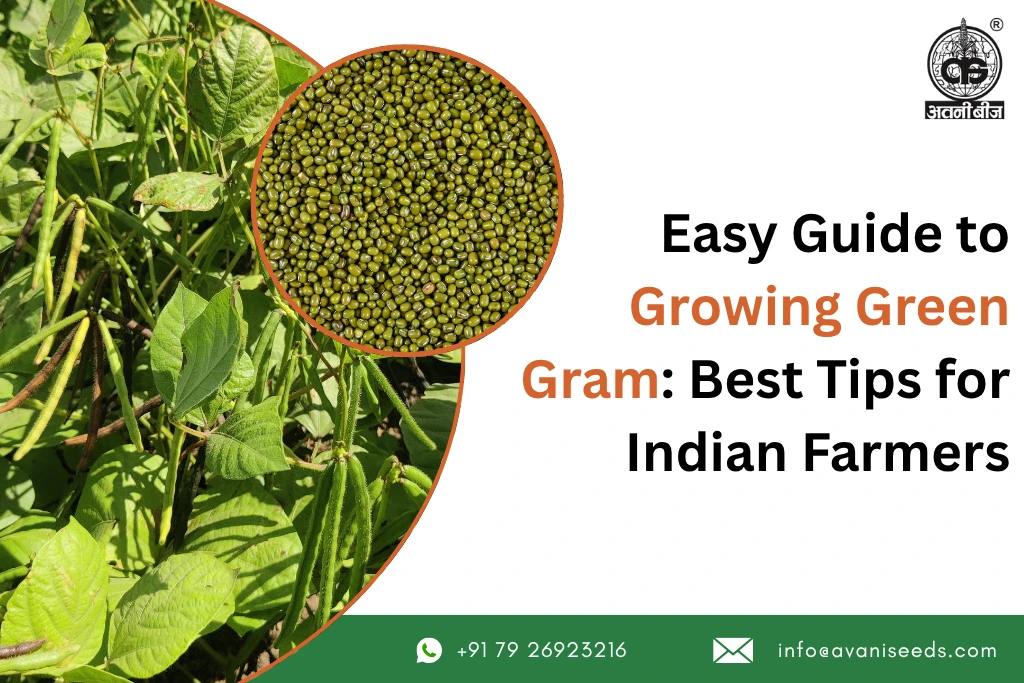Green gram, also known as moong dal, is one of the most popular pulses in India. It is packed with nutrients, easy to digest, and highly profitable for farmers. With increasing demand in both domestic and international markets, green gram cultivation in India has become a smart choice for many small and large-scale farmers.
Whether you’re new to farming or looking to improve your yield, this guide offers practical advice and essential green gram farming tips for beginners.
Why Grow Green Gram (Moong)?
Green gram is a short-duration, nitrogen-fixing crop. It improves soil fertility and fits well into crop rotation cycles. It can be grown during the Kharif, Rabi, and summer seasons, depending on the region. Farmers prefer green gram for its:
- Short growing cycle (60–70 days)
- Low water requirement
- Ability to improve soil health
- High market demand
Step-by-Step: How to Grow Moong Dal Crop
Here’s an easy-to-follow guide for growing green gram successfully:
1. Soil Preparation
Green gram grows best in well-drained loamy or sandy loam soils with a pH between 6.2 and 7.5. Avoid waterlogged fields. Plough the field 2–3 times and apply organic manure or compost before sowing.
2. Seed Selection and Treatment
Choose high-yield, disease-resistant varieties from trusted Green Gram (Moong) Seeds Producers. Varieties like PDM 139, IPM 2-3, SML 668, and ML 818 are known for better yields.
Seed rate:
- 12–15 kg per acre for Kharif
- 8–10 kg per acre for summer and Rabi
Seed treatment:
Before sowing, treat the seeds with Rhizobium culture and fungicides to protect against soil-borne diseases.
3. Sowing Time and Method
Sowing time depends on the season:
- Kharif: June–July
- Rabi: October–November
- Summer: March–April
Use a seed drill or sow manually in rows spaced 30 cm apart, with 10 cm between plants.
4. Irrigation
- Kharif crop usually doesn’t require irrigation due to rainfall.
- For summer and Rabi crops, irrigate at critical growth stages like flowering and pod development.
- Avoid water stagnation—it can damage the roots.
5. Weed and Pest Management
- Use a pre-emergence herbicide or do 1–2 manual weedings within the first 25 days.
- Watch out for Yellow Mosaic Virus, pod borers, and leaf spot diseases. Use recommended pesticides if needed, or choose disease-resistant seeds from certified Green Gram (Moong) Seeds Suppliers.
6. Fertilizer Application
- Apply DAP (Di-Ammonium Phosphate) at 50–60 kg per acre during sowing.
- Green gram fixes its own nitrogen, so excessive nitrogen fertilizers are not required.
7. Harvesting
Green gram is ready for harvest when most pods turn black or brown. Do not delay, as overripe pods may shatter. Harvest in the early morning to reduce grain loss, then dry and thresh the plants.
Post-Harvest Tips
- Dry the seeds under sunlight for 2–3 days to reduce moisture content.
- Store in clean, dry containers or bags.
- Use neem leaves or natural repellents to prevent insect attacks during storage.
Market Demand and Profit Potential
Green gram is always in demand due to its health benefits and use in Indian kitchens. It is also exported in large quantities. By choosing the right Green Gram (Moong) Seeds Suppliers and following proper practices, farmers can expect:
- Yield: 4–6 quintals per acre (depending on variety and care)
- Net profit: Higher than many other short-duration crops
Expert Tips for First-Time Growers
Here are a few quick green gram farming tips for beginners:
- Start with a small area if you’re new to moong cultivation.
- Always use quality seeds from certified Green Gram (Moong) Seeds Producers.
- Ensure good drainage to avoid fungal diseases.
- Monitor your crop regularly for pests and nutrient deficiencies.
- Use crop rotation to maintain soil health and avoid pest buildup.
Final Thoughts
With proper care, the right variety, and timely farming practices, green gram cultivation in India can be both sustainable and profitable. Whether you’re a seasoned farmer or just starting out, learning how to grow moong dal crop the right way can lead to great returns.
Choosing quality seeds and staying updated on modern farming techniques is key. Collaborate with trusted Green Gram (Moong) Seeds Suppliers and extension experts to get the most out of your harvest.



